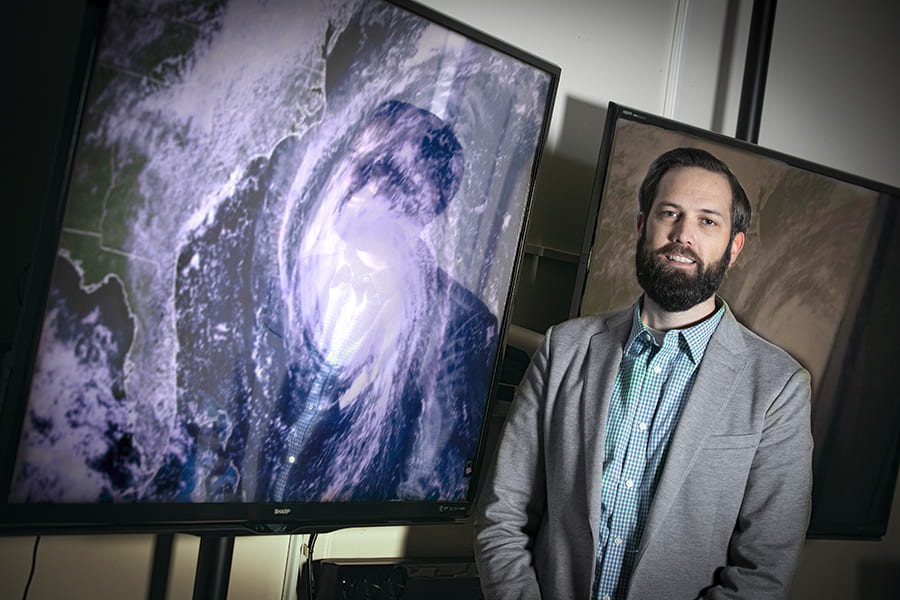From Study Confirms Climate Change Impacted Hurricane Florence’s Precipitation and Size on Stony Brook University News, January 2, 2020.
STONY BROOK, January 2, 2020 — A study led by Kevin Reed, PhD, Assistant Professor in the School of Marine and Atmospheric Sciences (SoMAS) at Stony Brook University, and published in Science Advances, found that Hurricane Florence produced more extreme rainfall and was spatially larger due to human-induced climate change.
Previous research has suggested that human influences such as emission of greenhouse gasses that alter climate does affect precipitation in extreme storms. The research in this study, however, is a first to use a “forecast attribution” framework that enables scientists to investigate the effect of climate change on individual storm events days in advance.
Reed explains the future tools of storm modeling including the approach by his team in this brief video.
Changes in extreme weather are one of the most serious ways society experiences the impact of climate change. Severe weather and natural disasters account for much damage and has a major economic impact on countries. Reed and colleagues nationally are investigating ways to better forecast extreme storms in the context of climate change.
In 2018, prior to the landfall of Hurricane Florence, Reed and colleagues made predictions based on simulations of the storm given climate change models. They predicted Hurricane Florence would be slightly more intense for a longer portion of the forecast period, rainfall amounts over the Carolinas would be increased by 50 percent due to climate change and warmer water temperatures, and the hurricane would be approximately 80 kilometers larger due to the effect of climate change on the large-scale environment around the storm.
“With our ability for additional ‘hindsight’ numerical modeling of the storm around climate change factors, we found predictions about increases in storm size and increased storm rainfall in certain areas to be accurate, even if the numbers and proportions are not exact,” explains Reed. “More importantly, this post-storm modeling around climate change illustrates that the impact of climate change on storms is here now and is not something only projected for our future.”
He said that while the post-storm analysis did show that the storm was slightly more intense during the forecast period due to climate change – as they predicted – as measured by minimum surface pressure and near-surface winds, the finding remains the most uncertain from the hindsight model.
One key finding of the post-storm model showed that Hurricane Florence was about nine kilometers larger in mean maximum diameter due to climate change. Additionally, rainfall amounts over large ranges were significantly increased. Mean total overland rainfall amounts associated with the forecasted storm’s core were increased by 4.9 ± 4.6% with local maximum amounts experiencing increases of 3.8 ± 5.7% due to climate change.
Reed emphasizes that by attributing climate change effects to individual storms, as his team did with Hurricane Florence, scientists are better able to communicate the direct impacts of climate change on extreme weather to the public.
The research is supported in part by the Stony Brook Foundation, National Science Foundation through the National Center for Atmospheric Research, and the Department of Energy’s Office of Science.
###
About Stony Brook University
Stony Brook University is going beyond the expectations of what today’s public universities can accomplish. Since its founding in 1957, this young university has grown to become a flagship as one of only four University Center campuses in the State University of New York (SUNY) system with more than 26,000 students and 2,600 faculty members, and 18 NCAA Division I athletic programs. Our faculty have earned numerous prestigious awards, including the Nobel Prize, Pulitzer Prize, Indianapolis Prize for animal conservation, Abel Prize and the inaugural Breakthrough Prize in Mathematics. The University offers students an elite education with an outstanding return on investment: U.S. News & World Report ranks Stony Brook among the top 50 public universities in the nation. Its membership in the Association of American Universities (AAU) places Stony Brook among the top 62 research institutions in North America. As part of the management team of Brookhaven National Laboratory, the University joins a prestigious group of universities that have a role in running federal R&D labs. Stony Brook University is a driving force in the region’s economy, generating nearly 60,000 jobs and an annual economic impact of more than $4.6 billion. Our state, country and world demand ambitious ideas, imaginative solutions and exceptional leadership to forge a better future for all. The students, alumni, researchers and faculty of Stony Brook University are prepared to meet this challenge.




